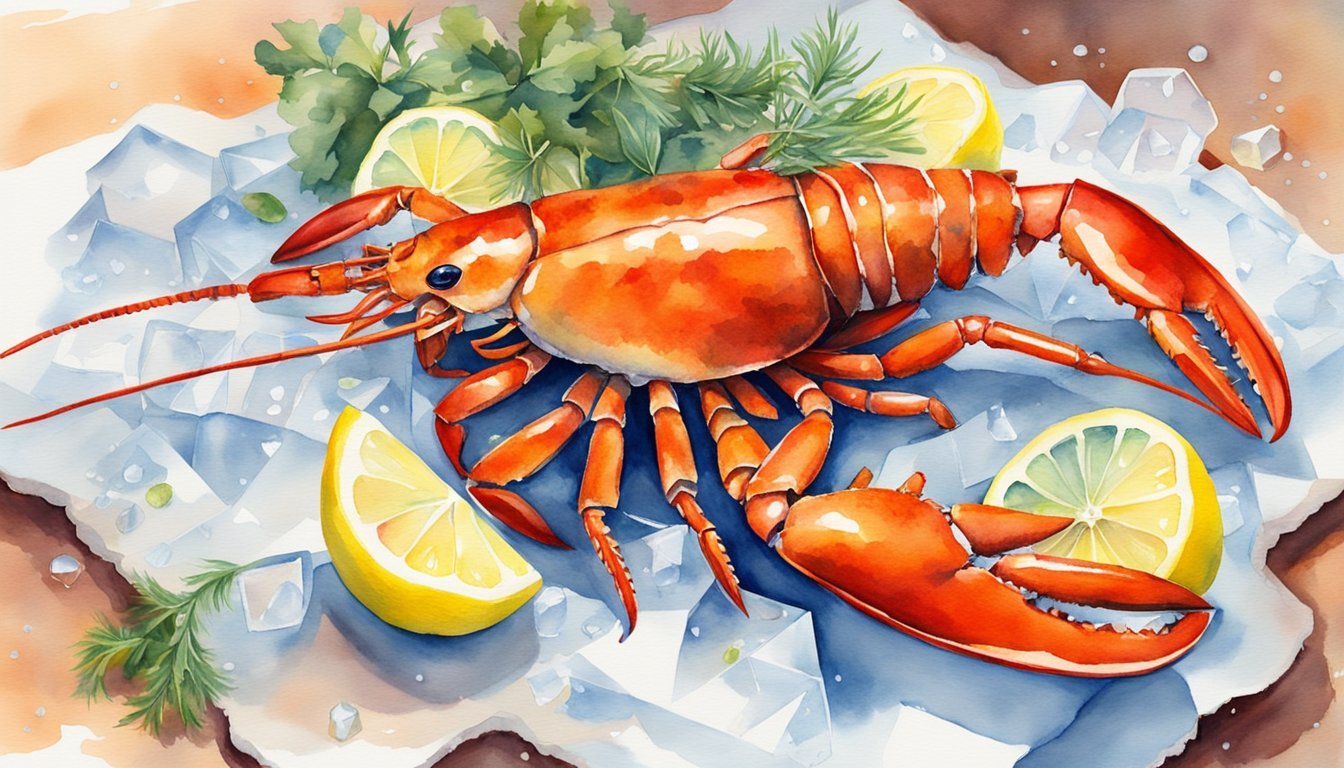Lobster Biology and Species
Lobsters are a fascinating group of marine crustaceans with a rich variety of species. They possess unique anatomical features and adapt well to their marine habitats.
Anatomical Features
Lobsters are easily identified by their large claws (chelae), muscular tail, and a hard protective exoskeleton. Their first three pairs of legs are equipped with claws, with the first set being considerably larger. These creatures have a distinct body divided into two main parts: the head and thorax are covered by a shell called the carapace, while the abdomen ends in a fan-like tail. Special anatomical parts include their compound eyes for vision and antennae for touch and smell.
- Claws and Legs: Vital for defense and handling prey.
- Exoskeleton: Provides protection and support.
- Antennae: Serve as sensors.
- Carapace: Shields the thorax and head.
- Abdomen: Houses swimmerets and ends in a tail.
Learn more about the anatomy of a lobster.
Species and Classification
Lobsters are classified under the phylum Arthropoda and the order Decapoda. Broadly, they can be divided into clawed lobsters (Nephropidae and Homaridae families) and spiny lobsters (Palinuridae family), which do not have large claws. Notable species include:
- American Lobster (Homarus americanus): One of the most valuable species, known for its substantial size and prevalence along the Atlantic Coast of North America.
- Norway Lobster (Nephrops norvegicus): Also called Dublin Bay prawn or langoustine, found mostly in the northeastern Atlantic Ocean and parts of the Mediterranean Sea.
- California Spiny Lobster (Panulirus interruptus): Characterized by the absence of large claws, found along the Pacific coasts of North America.
Read about different lobster species and their classifications.
Physiology and Behavior
Lobsters are known to be nocturnal and primarily prey on small marine organisms. They exhibit complex behaviors such as molting, where they shed their exoskeleton to grow, and sophisticated mating rituals. Their blue blood contains hemocyanin, which carries oxygen in place of the red hemoglobin found in humans. Lobsters gain their color from astaxanthin, and they can change color during the molting process.
- Nocturnal: Active mostly at night.
- Molting: Periodically shedding their exoskeleton for growth.
Discover how lobsters molt and behave.
Habitat and Distribution
Lobsters inhabit various regions in the ocean, from the rocky environments of the Atlantic Coast, including New England, to the shallow waters of the Norwegian shores and the deep sea near South Africa and Brazil. The habitat can range from shallow water to depths reaching several thousand feet. Their distribution includes major bodies of saltwater such as the Atlantic Ocean, Mediterranean Sea, and along the North American coast.
- Atlantic Lobster: Common in cool, rocky waters.
- Spiny Lobsters: Prefers warmer, coral reef environments.
Learn about the habitats of lobster species around the world.
Lobster as Seafood

Lobsters are a celebrated seafood known for their rich flavor and are a cornerstone in regional cuisines, especially in New England. The industry and culture surrounding them are as deep as the waters they inhabit, from the culinary artistry of dishes like lobster rolls to their significant economic impact.
Culinary Uses
Lobsters are treasured for their tender, sweet meat and play a starring role in various dishes. The American lobster, popularly known as Maine lobster, is often boiled or steamed and served whole, or its meat is used in soups, bisques, and lobster rolls. For a rich and indulgent dish, lobster tails may be used in recipes like lobster Thermidor, a creamy and savory classic dish.
Harvesting and Sustainability
Lobster fishing is a commercial endeavor with strict regulations to ensure sustainability. These regulations include size limits, restrictions on harvestable females, and limited fishing seasons. The sustainability status of lobsters depends on responsible fishing practices and respecting marine ecosystems.
Nutrition and Preparation
Lobster is not only favorable for its taste but also its health benefits; it is a source of high-quality protein, minerals, and omega-3 fatty acids with relatively low fat. Proper cooking techniques can influence both the texture of the lobster meat and its nutritional value. For example, boiling or steaming preserves the delicate texture of the meat and its subtle flavors.
Lobster in Culture and Economy
Lobsters are deeply ingrained in the culture and economy of coastal regions like New England. The Maine lobster is a cultural icon and a significant economic driver, with festivals celebrating this crustacean. In restaurants, from casual to fine dining, lobster dishes are often featured as premium offerings, reflecting both tradition and prestige.
Seasonal and Regional Varieties
Different regions and seasons offer distinct varieties of lobster. For instance, the Maine lobster is famous for its summer and fall harvests, which is a peak season for soft-shell lobsters with sweeter, tender meat. Conversely, European lobster, spiny lobster, and the Norway lobster, also known as Dublin Bay prawn or scampi, offer different flavors and textures and are popular in various international cuisines.

